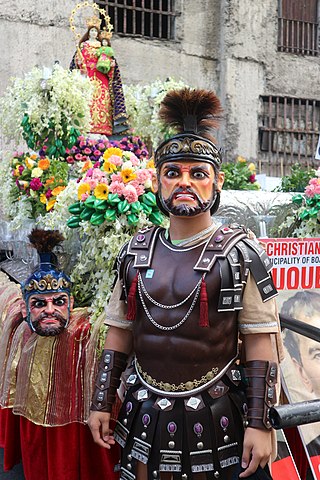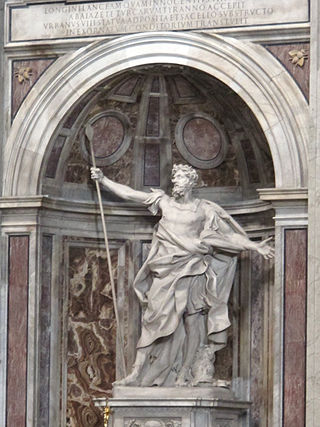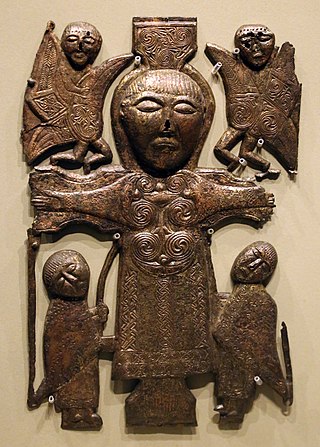
Longinus is the name given to the unnamed Roman soldier who pierced the side of Jesus with a lance; who in medieval and some modern Christian traditions is described as a convert to Christianity. His name first appeared in the apocryphal Gospel of Nicodemus. The lance is called in Christianity the "Holy Lance" (lancea) and the story is related in the Gospel of John during the Crucifixion. This act is said to have created the last of the Five Holy Wounds of Christ.

The Holy Lance, also known as the Lance of Longinus, the Spear of Destiny, or the Holy Spear, is alleged to be the lance that pierced the side of Jesus as he hung on the cross during his crucifixion. As with other instruments of the Passion, the lance is only briefly mentioned in the Christian Bible, but later became the subject of extrabiblical traditions in the medieval church. Relics purported to be the lance began to appear as early as the 6th century, originally in Jerusalem. By the Late Middle Ages, relics identified as the spearhead of the Holy Lance had been described throughout Europe. Several of these artifacts are still preserved to this day.

On the Sublime is a Roman-era Greek work of literary criticism dated to the 1st century C.E. Its author is unknown, but is conventionally referred to as Longinus or Pseudo-Longinus. It is regarded as a classic work on aesthetics and the effects of good writing. The treatise highlights examples of good and bad writing from the previous millennium, focusing particularly on what may lead to the sublime.

The Holy Sponge is one of the Instruments of the Passion of Jesus. It was dipped in vinegar, most likely posca, a regular beverage of Roman soldiers, and offered to Jesus to drink from during the Crucifixion, according to Matthew 27:48, Mark 15:36, and John 19:29.
Cassius Longinus may refer to:
Cassius Longinus was a Greek rhetorician and philosophical critic. Born in either Emesa or Athens, he studied at Alexandria under Ammonius Saccas and Origen the Pagan, and taught for thirty years in Athens, one of his pupils being Porphyry. Longinus did not embrace the Neoplatonism then being developed by Plotinus, but continued as a Platonist of the old type and his reputation as a literary critic was immense. During a visit to the east, he became a teacher, and subsequently chief counsellor to Zenobia, queen of Palmyra. It was by his advice that she endeavoured to regain her independence from Rome. Emperor Aurelian, however, crushed the revolt, and Longinus was executed.

In Catholic tradition, the Five Holy Wounds, also known as the Five Sacred Wounds or the Five Precious Wounds, are the five piercing wounds that Jesus Christ suffered during his crucifixion. The wounds have been the focus of particular devotions, especially in the late Middle Ages, and have often been reflected in church music and art.

Victor of Marseilles was an Egyptian Christian martyr. He is venerated as a saint in the Catholic Church and the Eastern Orthodox Church.

Casca is a series of historical fantasy novels created by author Barry Sadler in 1979. The stories revolve around the exploits of Casca Rufio Longinus, the Roman legionary who drove the Holy Lance into the side of Jesus Christ on Golgotha. As a result of this action, Casca is cursed with immortality, and he is to wander the Earth aimlessly, always as a soldier, until the Second Coming. The character is loosely based on the Longinus legend of Christianity.

Trajan's Second Dacian War was fought between 105 and 106 because the Dacian king, Decebalus, had broken his peace terms with the Roman Emperor Trajan from the Trajan's First Dacian War.

Centurion is a historical fiction novel (ISBN 0755327764) written by Simon Scarrow, published by Headline Book Publishing in 2007. It is book 8 in the Eagles of the Empire series, continuing Macro and Cato's adventures in the eastern provinces of the Roman Empire that began in The Eagle in the Sand.

The Moriones Festival is a lenten and religious festival held annually on Holy Week on the island of Marinduque, Philippines. The "Moriones" are men and women in costumes and masks replicating the garb of biblical Imperial Roman soldiers as interpreted by locals. The Moriones tradition has inspired the creation of other festivals in the Philippines where cultural practices is turned into street festivals.

Stephaton, or Steven, is the name given in medieval Christian traditions to the Roman soldier or bystander, unnamed in the Bible, who offered Jesus a sponge soaked in vinegar wine at the Crucifixion. In later depictions of the Crucifixion, Stephaton is frequently portrayed with Longinus, the soldier who pierced Jesus' side with a spear.

The Great Commandment is a 1939 American Christian film directed by Irving Pichel, which portrays the conversion to Christianity of a young Zealot, Joel, and the Roman soldier Longinus through the teachings of Jesus in his Parable of the Good Samaritan. It was co-produced by Rev. James K. Friedrich and released by Cathedral Films in 1939. Its theatrical release was in 1941 by Twentieth Century Fox.
Longinus of Cardala or Longinus the Bald was a high-ranking Eastern Roman official and rebel leader from Isauria.

Saint Longinus is a sculpture by the Italian artist Gian Lorenzo Bernini. Completed in 1638, the marble sculpture sits in the north-eastern niche in the crossing of St. Peter's Basilica in Vatican City. It is over four meters high and was commissioned by Pope Urban VIII, a great patron of Bernini.

The term Crucifixion plaque refers to small early medieval sculptures with a central panel of the still alive but crucified Jesus surrounded by four smaller ancillary panels, consisting of Stephaton and Longinus in the lower quadrants, and two hovering attendant angels in the quadrants above his arms. Notable examples are found in classical Roman and 8th to mid-12th century Irish Insular art.

The Clonmacnoise Crucifixion Plaque is a late-10th or early-11th century Irish gilt-bronze sculpture showing the Crucifixion of Jesus, with two attendant angels hovering above his arms to his immediate left and right. Below them are representations of the Roman soldiers Stephaton and Longinus driving spears into his chest.
Hathor 4 – Coptic calendar – Hathor 6














